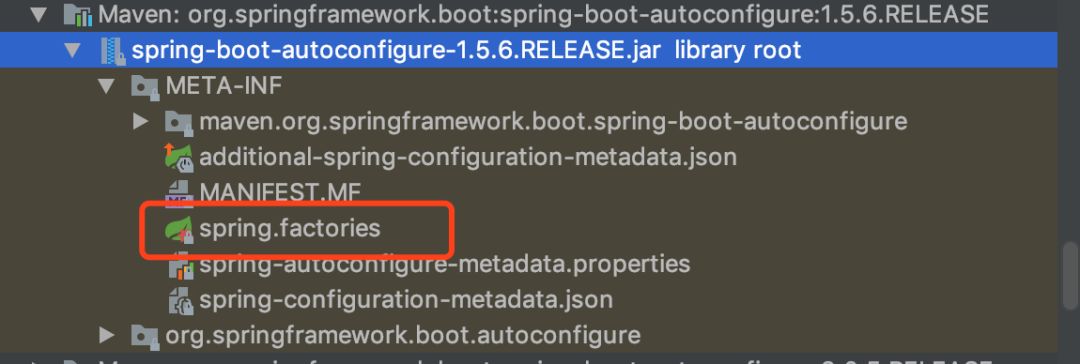一、啟動注解 @SpringBootApplication
@Target(ElementType.TYPE)
@Retention(RetentionPolicy.RUNTIME)
@Documented
@Inherited
@SpringBootConfiguration
@EnableAutoConfiguration
@ComponentScan(excludeFilters = { @Filter(type = FilterType.CUSTOM, classes = TypeExcludeFilter.class),
@Filter(type = FilterType.CUSTOM, classes = AutoConfigurationExcludeFilter.class) })
public @interface SpringBootApplication {
// ... 此處省略源碼
}
查看源碼可發現,@SpringBootApplication是一個復合注解,包含了@SpringBootConfiguration,@EnableAutoConfiguration,@ComponentScan這三個注解
@SpringBootConfiguration 注解,繼承@Configuration注解,主
要用于加載配置文件
@SpringBootConfiguration繼承自@Configuration,二者功能也一致,標注當前類是配置類, 并會將當前類內聲明的一個或多個以@Bean注解標記的方法的實例納入到spring容器中,并且實例名就是方法名。
@EnableAutoConfiguration 注解,開啟自動配置功能
@EnableAutoConfiguration可以幫助SpringBoot應用將所有符合條件的@Configuration配置都加載到當前SpringBoot創建并使用的IoC容器。借助于Spring框架原有的一個工具類:SpringFactoriesLoader的支持,@EnableAutoConfiguration可以智能的自動配置功效才得以大功告成
@ComponentScan 注解,主要用于組件掃描和自動裝配
@ComponentScan的功能其實就是自動掃描并加載符合條件的組件或bean定義,最終將這些bean定義加載到容器中。我們可以通過basePackages等屬性指定@ComponentScan自動掃描的范圍,如果不指定,則默認Spring框架實現從聲明@ComponentScan所在類的package進行掃描,默認情況下是不指定的,所以SpringBoot的啟動類最好放在root package下。
二、Controller 相關注解
@Controller
控制器,處理http請求。
@RestController 復合注解
查看@RestController源碼
@Target(ElementType.TYPE)
@Retention(RetentionPolicy.RUNTIME)
@Documented
@Controller
@ResponseBody
public @interface RestController {
/**
* The value may indicate a suggestion for a logical component name,
* to be turned into a Spring bean in case of an autodetected component.
* @return the suggested component name, if any (or empty String otherwise)
* @since 4.0.1
*/
@AliasFor(annotation = Controller.class)
String value() default "";
}
從源碼我們知道,@RestController注解相當于@ResponseBody+@Controller合在一起的作用,RestController使用的效果是將方法返回的對象直接在瀏覽器上展示成json格式.
@RequestBody
通過HttpMessageConverter讀取Request Body并反序列化為Object(泛指)對象
@RequestMapping
@RequestMapping 是 Spring Web 應用程序中最常被用到的注解之一。
這個注解會將 HTTP 請求映射到 MVC 和 REST 控制器的處理方法上
@GetMapping用于將HTTP get請求映射到特定處理程序的方法注解
注解簡寫:@RequestMapping(value = "/say",method = RequestMethod.GET)等價于:@GetMapping(value = "/say")
GetMapping源碼
@Target(ElementType.METHOD)
@Retention(RetentionPolicy.RUNTIME)
@Documented
@RequestMapping(method = RequestMethod.GET)
public @interface GetMapping {
//...
}
是@RequestMapping(method = RequestMethod.GET)的縮寫
@PostMapping用于將HTTP post請求映射到特定處理程序的方法注解
@Target(ElementType.METHOD)
@Retention(RetentionPolicy.RUNTIME)
@Documented
@RequestMapping(method = RequestMethod.POST)
public @interface PostMapping {
//...
}
是@RequestMapping(method = RequestMethod.POST)的縮寫
三、取請求參數值
@PathVariable:獲取url中的數據
@Controller
@RequestMapping("/User")
public class HelloWorldController {
@RequestMapping("/getUser/{uid}")
public String getUser(@PathVariable("uid")Integer id, Model model) {
System.out.println("id:"+id);
return "user";
}
}
請求示例:http://localhost:8080/User/getUser/123
@RequestParam:獲取請求參數的值
@Controller
@RequestMapping("/User")
public class HelloWorldController {
@RequestMapping("/getUser")
public String getUser(@RequestParam("uid")Integer id, Model model) {
System.out.println("id:"+id);
return "user";
}
}
請求示例:http://localhost:8080/User/getUser?uid=123
@RequestHeader 把Request請求header部分的值綁定到方法的參數上
@CookieValue 把Request header中關于cookie的值綁定到方法的參數上
四、注入bean相關
@Repository
DAO層注解,DAO層中接口繼承JpaRepository,需要在build.gradle中引入相關jpa的一個jar自動加載。
Repository注解源碼
@Target({ElementType.TYPE})
@Retention(RetentionPolicy.RUNTIME)
@Documented
@Component
public @interface Repository {
/**
* The value may indicate a suggestion for a logical component name,
* to be turned into a Spring bean in case of an autodetected component.
* @return the suggested component name, if any (or empty String otherwise)
*/
@AliasFor(annotation = Component.class)
String value() default "";
}
@Service
@Target({ElementType.TYPE})
@Retention(RetentionPolicy.RUNTIME)
@Documented
@Component
public @interface Service {
/**
* The value may indicate a suggestion for a logical component name,
* to be turned into a Spring bean in case of an autodetected component.
* @return the suggested component name, if any (or empty String otherwise)
*/
@AliasFor(annotation = Component.class)
String value() default "";
}
- @Service是@Component注解的一個特例,作用在類上
- @Service注解作用域默認為單例
- 使用注解配置和類路徑掃描時,被@Service注解標注的類會被Spring掃描并注冊為Bean
- @Service用于標注服務層組件,表示定義一個bean
- @Service使用時沒有傳參數,Bean名稱默認為當前類的類名,首字母小寫
- @Service(“serviceBeanId”)或@Service(value=”serviceBeanId”)使用時傳參數,使用value作為Bean名字
@Scope作用域注解
@Scope作用在類上和方法上,用來配置 spring bean 的作用域,它標識 bean 的作用域
@Scope源碼
@Target({ElementType.TYPE, ElementType.METHOD})
@Retention(RetentionPolicy.RUNTIME)
@Documented
public @interface Scope {
/**
* Alias for {@link #scopeName}.
* @see #scopeName
*/
@AliasFor("scopeName")
String value() default "";
@AliasFor("value")
String scopeName() default "";
ScopedProxyMode proxyMode() default ScopedProxyMode.DEFAULT;
}
屬性介紹
value
singleton 表示該bean是單例的。(默認)
prototype 表示該bean是多例的,即每次使用該bean時都會新建一個對象。
request 在一次http請求中,一個bean對應一個實例。
session 在一個httpSession中,一個bean對應一個實例。
proxyMode
DEFAULT 不使用代理。(默認)
NO 不使用代理,等價于DEFAULT。
INTERFACES 使用基于接口的代理(jdk dynamic proxy)。
TARGET_CLASS 使用基于類的代理(cglib)。
@Entity實體類注解
@Table(name ="數據庫表名"),這個注解也注釋在實體類上,對應數據庫中相應的表。
@Id、@Column注解用于標注實體類中的字段,pk字段標注為@Id,其余@Column。
@Bean產生一個bean的方法
@Bean明確地指示了一種方法,產生一個bean的方法,并且交給Spring容器管理。支持別名@Bean("xx-name")
@Autowired 自動導入
- @Autowired注解作用在構造函數、方法、方法參數、類字段以及注解上
- @Autowired注解可以實現Bean的自動注入
@Component
把普通pojo實例化到spring容器中,相當于配置文件中的
雖然有了@Autowired,但是我們還是要寫一堆bean的配置文件,相當麻煩,而@Component就是告訴spring,我是pojo類,把我注冊到容器中吧,spring會自動提取相關信息。那么我們就不用寫麻煩的xml配置文件了
五、導入配置文件
@PropertySource注解
引入單個properties文件:
@PropertySource(value = {"classpath : xxxx/xxx.properties"})
引入多個properties文件:
@PropertySource(value = {"classpath : xxxx/xxx.properties","classpath : xxxx.properties"})
@ImportResource導入xml配置文件
可以額外分為兩種模式 相對路徑classpath,絕對路徑(真實路徑)file
注意:單文件可以不寫value或locations,value和locations都可用
相對路徑(classpath)
- 引入單個xml配置文件:@ImportSource("classpath : xxx/xxxx.xml")
- 引入多個xml配置文件:@ImportSource(locations={"classpath : xxxx.xml" , "classpath : yyyy.xml"})
絕對路徑(file)
- 引入單個xml配置文件:@ImportSource(locations= {"file : d:/hellxz/dubbo.xml"})
- 引入多個xml配置文件:@ImportSource(locations= {"file : d:/hellxz/application.xml" , "file : d:/hellxz/dubbo.xml"})
取值:使用@Value注解取配置文件中的值
@Value("${properties中的鍵}")
private String xxx;
@Import 導入額外的配置信息
功能類似XML配置的,用來導入配置類,可以導入帶有@Configuration注解的配置類或實現了ImportSelector/ImportBeanDefinitionRegistrar。
使用示例
@SpringBootApplication
@Import({SmsConfig.class})
public class DemoApplication {
public static void main(String[] args) {
SpringApplication.run(DemoApplication.class, args);
}
}
六、事務注解 @Transactional
在Spring中,事務有兩種實現方式,分別是編程式事務管理和聲明式事務管理兩種方式
編程式事務管理:編程式事務管理使用TransactionTemplate或者直接使用底層的PlatformTransactionManager。對于編程式事務管理,spring推薦使用TransactionTemplate。
聲明式事務管理:建立在AOP之上的。其本質是對方法前后進行攔截,然后在目標方法開始之前創建或者加入一個事務,在執行完目標方法之后根據執行情況提交或者回滾事務,通過@Transactional就可以進行事務操作,更快捷而且簡單。推薦使用
七、全局異常處理
@ControllerAdvice 統一處理異常
@ControllerAdvice 注解定義全局異常處理類
@ControllerAdvice
public class GlobalExceptionHandler {
}
@ExceptionHandler 注解聲明異常處理方法
@ControllerAdvice
public class GlobalExceptionHandler {
@ExceptionHandler(Exception.class)
@ResponseBody
String handleException(){
return "Exception Deal!";
}
}
-
JAVA
+關注
關注
19文章
2974瀏覽量
104968 -
容器
+關注
關注
0文章
499瀏覽量
22093 -
spring
+關注
關注
0文章
340瀏覽量
14368 -
Boot
+關注
關注
0文章
150瀏覽量
35890 -
SpringBoot
+關注
關注
0文章
174瀏覽量
193
發布評論請先 登錄
相關推薦
Springboot是如何獲取自定義異常并進行返回的
Spring Boot的注解原理是什么
Spring Boot中常見的各類型注解的使用方式
Spring Boot常用注解與使用方式
求一種SpringBoot定時任務動態管理通用解決方案
什么是 SpringBoot?

SpringBoot常用注解及使用方法1
SpringBoot常用注解及使用方法2
Springboot常用注解合集





 SpringBoot常用注解及原理
SpringBoot常用注解及原理












評論